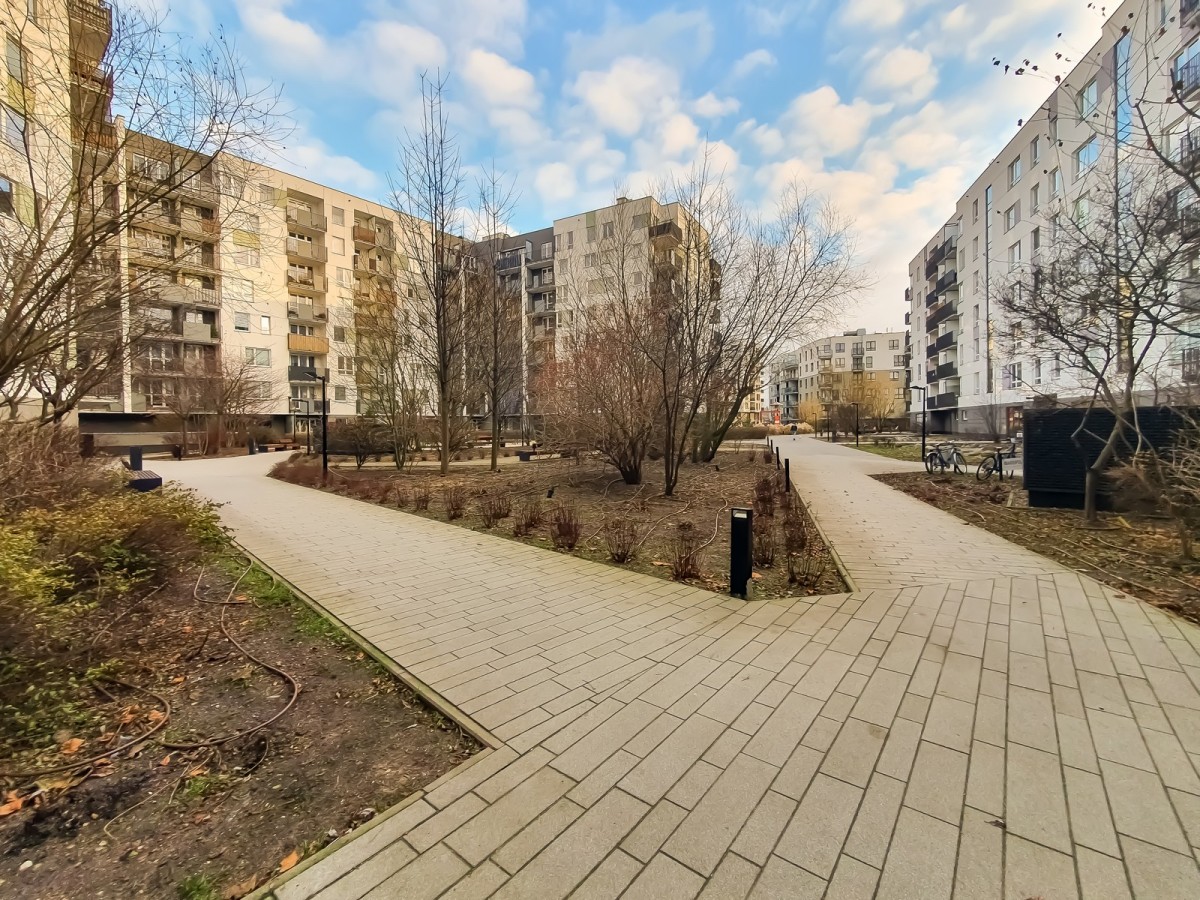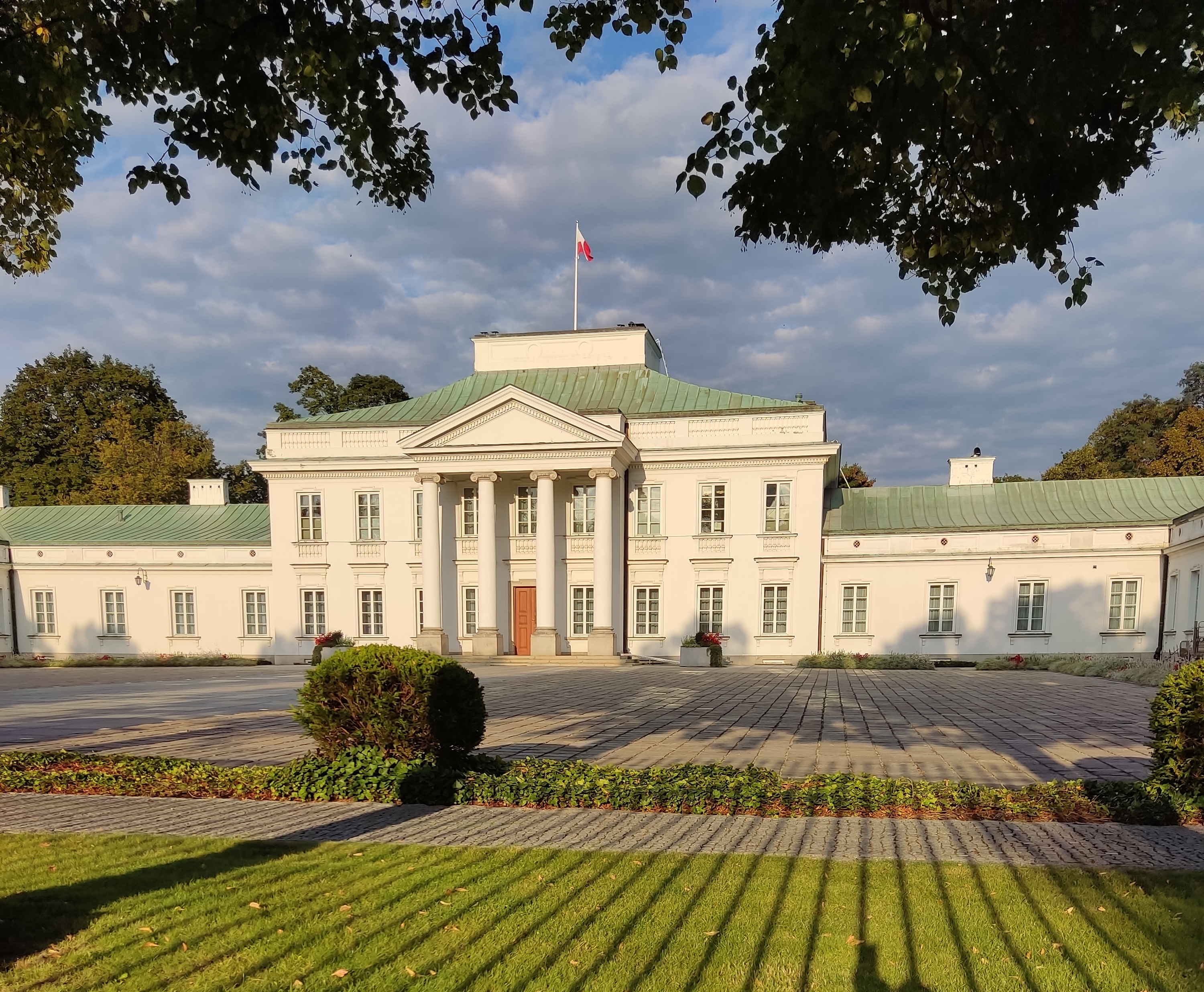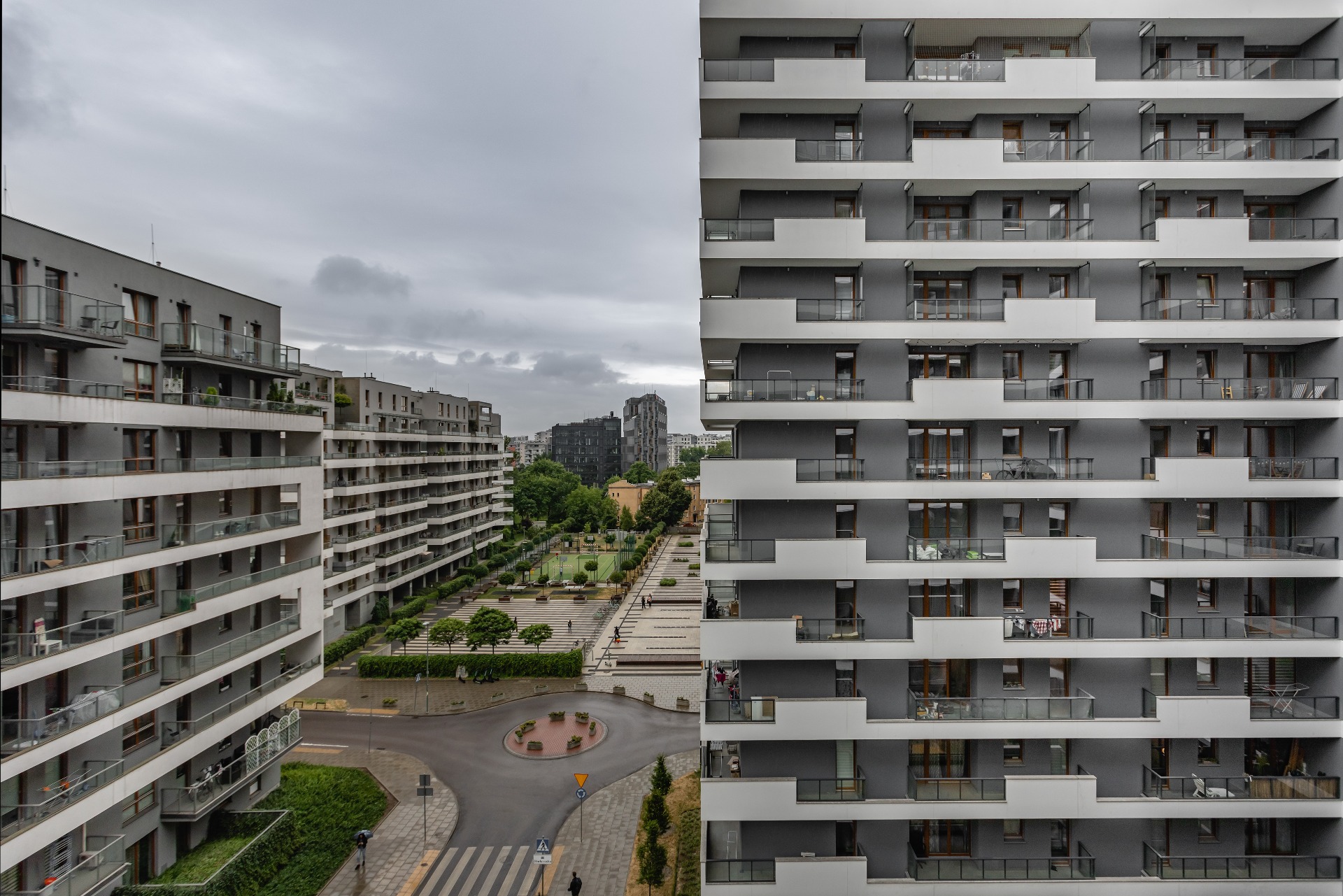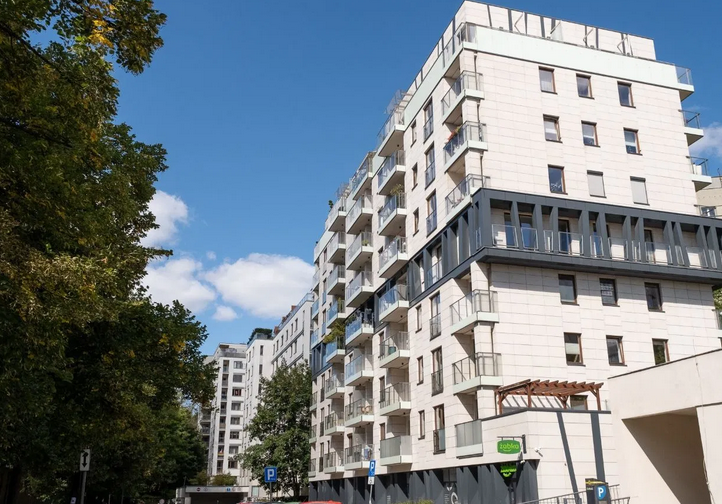Mokotow. Microdistrict (obszar) „Stary Mokotów” (Stary Mokotów)

The name Stary Mokotów was coined for the needs of the Municipal Information System. In fact, previously this was the name of the oldest part of the Mokotów district (primarily the block of streets included in the National Register of Monuments: al. Niepodległości – Odolańska – Dąbrowskiego).
Stary Mokotów is located in the northern part of Mokotowa (Górny Mokotów) on the Vistula escarpment. From the east it is bordered by the Sielce microdistrict (which is already located in Dolnym Mokotowie), from the south by Wierzbnem, from the west by Wyględowem, and in the north by the Śródmieście district.
The boundaries of the Stary Mokotów microdistrict are determined as follows: St. Spacerowa, Boya-Żeleńskiego, Batorego (along the border of the districts Śródmieście/Mokotów) -Chodkiewicza – Wołoska – Racławicka – Dolna to the height of the church św. Michała – the crown of Skarpy Warszawskiej in a northerly direction, starting from the street. Dolnej at the height of the church św. Michała, crossing the street. Boryszewską, Belgijską, Morskie Oko, Dworkową between st. Słoneczną and Wybieg reaching the street. Spacerowej.
History of the Stary Mokotów neighborhood
Stary Mokotów is the oldest part of Mokotowa. The original name "Mokotowo" most likely comes from the name of the Prussian owner of the village and was first mentioned in documents in 1367. Although the area has been inhabited since at least the early Middle Ages.
For centuries it was a princely village, closely cooperating with Jazdowem, where the prince was located. Mokotowo supplied food to the Warsaw market. In the 17th century the village fell into decay and lost its significance. In the 18th century Brick factories opened here, majestic villas and estates were built on the streets, and impressive gardens were created on the slope.
At the turn of the 19th and 20th centuries. The lands of the mokotowskiego farm were divided and new streets of the current Starego Mokotowa were designated, including Rakowiecką, Narbutta, Madalińskiego and Szustra (now Dąbrowskiego). Stary Mokotów, like many other suburbs of Warsaw, was incorporated into the city only at the beginning of 1916. Buildings for the SGH and SGGW universities, offices, scientific institutes, hospitals and residences were built, preserving the green character of the area.
During World War II, Mokotów was heavily damaged; bombs fell here as early as September 1, 1939. After the capture of the capital by the Germans, Mokotów became an Aryan district. Residents were evicted, and military personnel moved into the buildings. During the Warsaw Uprising, bloody battles took place here and the area was destroyed.
Stary Mokotów is a prestigious district of Warsaw with many squares and parks, interesting architecture and trendy cafes. This is mainly a residential area. At the same time, there are several embassies, many parks and historical attractions here.
Properties in Starym Mokotowie
Today the nature of development in Starym Mokotowie is varied. There are former villas representing a huge architectural heritage, as well as post-war apartment buildings and modern high-rise buildings.
Residential complex Rezydencja Łowicka
Located in a very prestigious part of Mokotowa in the Starego Mokotowa neighborhood on Łowicka street. It is located between Rakowiecka and Ratslawicka streets, oriented from north to south. Intersected by Narbutta, Madalińskiego, Różyckiego, Dąbrowskiego (jako rondo Pawła Jasienicy) and Wiktorska streets.
The cozy buildings, beautiful mansions in the area and fantastic infrastructure make it a special place. This is a quiet and peaceful area.
In the immediate vicinity there is commercial, service and gastronomic infrastructure: restaurant, supermarket, grocery store. There is a kindergarten, playgrounds, primary school, secondary school/technical school. Recreation area - park. Public transport: bus and tram.
Residential complex Przy Królikarnia
The residential complex Przy Królikarnia is located in the prestigious residential part of Starego Mokotowa, surrounded by greenery, near the Królikarnia park. It consists of four buildings of different heights - from 4 to 13 floors, forming a spectacular and harmonious area with apartments.
The complex has a full professional service provided by reception, intercom and security system throughout the entire territory. Secure parking with direct access to residential floors. There is a patio in the middle - an area where you can sit and relax after a working day. There is a children's playground on the territory of the complex, accessible only to residents.
Residents have at their disposal a sports and fitness complex with a swimming pool, sauna, gym and aerobics room. Parking with direct access to the residential levels.
The complex is located in the Mokotów Górny area, ul. Wielicka. Full infrastructure, shops, restaurants, pharmacies, clinics, services. Also nearby are numerous kindergartens, schools and universities, the Varshavyanka sports complex with a swimming pool, fitness center, sports fields and tennis courts. Nearby is a school and kindergarten.
Shops, service points, restaurants and cafes complement the comfort of living in this area. In the immediate vicinity of the complex there is everything that Stary Mokotów is famous for. Among the green streets you can easily find atmospheric pubs. A few minutes' walk will take you to the Arkadia and Królikarnia parks. Nearby metro, bus and tram stops. Excellent transport in all directions.
Residential building at Madalińskiego 50/52
The house is located in Warsaw, Mokotów district, st. Antoniego Józefa Madalińskiego. Center Starego Mokotowa. The building was erected in the 1970s, was built for employees of the Office of the Council of Ministers, had an underground garage for a dozen cars, which at that time bore signs of luxury.
The house at Madalińskiego 50/52 in Starym Mokotowie represents a cross-section of the history of the Polish People's Republic and the Third Republic of Poland over the last 50 years.
There is complete infrastructure nearby, excellent transport links - 5 minutes to the Pole Mokotowskie metro station. Very nice, thriving community, nice quiet area. 300 meters to the green park Antoniego Słonimskiego.
Residential complex Pole-Mokotowskie.pl
Located at: ul. Stefana Batorego 16, Stary Mokotów, Mokotów, Warszawa (2.2 km from the center). Commissioned in the third quarter of 2021. The complex has 60 apartments ranging from 17 m2. All premises have separate land and mortgage books.
Stefana Batorego 16 is one of the most prestigious areas of Warsaw, located right on Pole-Mokotowskie. A developed public transport network provides easy and quick access to anywhere in the city: 100 m to the Pole Mokotovskie metro station; 100 m to tram and bus stop; 100 m to the main building of the Warsaw School of Economics, 300 m to the National Library.
There are 46 educational institutions in the immediate vicinity of the Pole-Mokotowskie.pl investment. Nearest: primary school at a distance of 190 m, school at a distance of 190 m, Warsaw School of Economics at a distance of 290 m. Access to medical care is provided by hospitals: InviMed - 380 m, NZOZ "SANA" - 420 m, Medic House Medical Center - 640 m Nearby, 170 m away is Delikatesy "Blask", 220 m away - Carrefour Express, 230 m away - Paulinka. Near the investment Pole-Mokotowskie.pl there is a running track 250 m away and a playground/court 250 m away.
Investment properties in the Stary Mokotów neighborhood
The following residential complexes are currently under construction in the Stary Mokotów microdistrict:
OAK Lane. Address: st. Kielecka 18 , Stary Mokotów, Mokotów, Warszawa (2.9 km from center)
Widoki Mokotów. Address: st. Puławska , Stary Mokotów, Mokotów, Warszawa (3.4 km from center)
Kujawska 3. Address: st. Kujawska 3 , Stary Mokotów, Mokotów, Warszawa (2.3 km from center)
Rezydencja Łowicka. Address: st. Łowicka 22 , Stary Mokotów, Mokotów, Warszawa (3.2 km from center)
If you wish, the OKEASK company will tell you in detail about these objects and select an apartment for you. Just write a request on our website https://okeask.com/en.
Sights of the Stary Mokotów microdistrict:
- Mokotowskie Rogatki (rogatkowskie Pavilions) – symmetrical paired historical classical pavilions on the current Plac Unii Lubelskiej square were built in 1816-1818. In one pavilion there was a police superintendent, and in the other there was a tax collector who accepted tolls for entering the city. The buildings are included in the register of monuments. Mokotowskie Rogatki (or outposts) are located on the border of Mokotowa and Śródmieścia, this is where Mokotów begins.
- Dom Wedla on the corner of Puławskiej and Madalińskiego streets (1936). In a house that belonged to Jan Wedel, owner of the famous chocolate factory "E. Vedel" there was a company store. It was Mokotowa's most famous residential building - with a garbage chute and elevators. A painting by the famous artist Zofia Stryenska, Gural Dance, still hangs in the hall. It is built according to the principles of functional architecture. See the bas-relief of a tiger above the entrance and the recreated neon light installed on the roof.
- Domek Gotycki (Gothic House or Pigeon Tower) (Pulawska St., 59) - a symbol of Starego Mokotowa. The building was built at the end of the 18th century, there used to be a dovecote here. Now it houses a clock repair shop. Every day the clock on the tower plays “Marsz" Mokotowa" is the area's unofficial anthem, written during wartime.
- Domek Mauretański (Moorish House), st. Puławska, 55. It was built for Isabella Lubomirska and became part of the romantic architectural ensemble of the Morskie Oko park. The building is in a neo-Gothic style with oriental elements. Here was the gate to the Mon Coteau estate and the gatekeeper's cottage - today there is a gallery inside.
- Apartment house Chirshitsev (ul. Sandomierska, 23). This is the oldest stone structure in Mokotowie and the first apartment building in the area. Previously belonged to a family of famous bakers in Warsaw.
- Pałac Szustra (Schuster Palace, also Lubomirski Palace) is a palace in Warsaw, located at 2 Morskie Oko Street in the Morskie Oko Park. The two-story palace was built in 1772-1774 by Isabella Lubomirska. This was the main building of the Mon coteau estate. Reconstructions of the building were carried out in 1776, 1845 (after the purchase by F. Szustróm), 1852. In 1899, the Szustrów mausoleum was erected near the Palace. During World War II, the Germans cut down almost the entire park, and the palace itself burned down in 1944. After the war, the palace was rebuilt in 1962-1965. Currently, the Warsaw Musical Society is located here. Stanislava Moniuszko.
- Areszt Śledczy w Warszawie-Mokotowie (więzienie na Rakowieckiej, więzienie mokotowskie). The building of the former Mokotów prison (Rakowiecka 37), built at the beginning of the 20th century. The prison is currently closed. In its place, the Muzeum Żołnierzy Wyklętych i Więźniów Politycznych PRL (Museum of the Damned Soldiers and Political Prisoners of the People's Republic of Poland) was built.
- Zespół zabudowań d. Domu Sierot Dziewcząt (Former Home for Orphan Girls). Rakowiecka Street 21. This brick neo-Gothic building was built in 1899-1900. Now there is a music school here, and previously it housed the Warsaw Charitable Society orphanage, a state orphanage, a primary school and the Warsaw Family Assistance Center.
Parks in the Stary Mokotów neighborhood
- Park Promenada - Morskie Oko (Promenada Park - Morskie Oko) - a municipal park complex, including the historical palace and park complex (former Szustra Park and Promenada Park) and the post-war Morskie Oko Park. The park is located between the streets: Puławską, Dworkową, Belwederską and Promenada on the Warsaw Escarpment and the territory of the Podskarpia.
The Morskie Oko and Promenada parks are connected; their lower part is located in the Sielce neighborhood. Previously, they were part of a romantic garden and palace structure designed for Princess Isabella Czartoryska Lubomirska. Then the estate passed to Anna Tyshkevichskaya Potocka. This place was then called Mon coteau (moje wzgórze).
The lower part of the park complex is a popular entertainment area known as the Promenada. The park area includes, among others, the Szustra Palace, the tomb of the Szustrów family from 1899 and the monument to Jan Matejko. The park's water system consists of ponds, including the Morskie Oko and Promenada ponds.
The main path is planted with double rows of linden trees. It leads to a flower bed along the axis of the palace. Around the building, old-growth trees with magnificent oak specimens - natural monuments - have been preserved. About 90 species of trees, mostly deciduous, grow in the park complex. The most numerous trees are ash, linden, plane trees and maples, but rarer species can also be found here, such as the coffee tree or catalpa. The park is not fenced and is publicly accessible.
- Pole Mokotowskie Park, Józefa Piłsudskiego Park is a park complex located on the territory of 3 districts of Warsaw: Mokotowa, Ochoty and Śródmieścia. Administratively, most of the park is located in the Ochota district. This is Mokotowa's most famous park. One part of it is called Józefa Piłsudskiego Park. Previously, there was a military and civilian airport at Pole Mokotowskie. Until 1939, there was also a hippodrome here.
Today Pole Mokotowskie is a place for recreation for residents of the area, walking, picnics, and active recreation. There is a bicycle path throughout the park. There is also a monument to a lucky dog and a monument to fallen pilots. In this area are the General Statistical Office, several buildings of the National Library, the City Horticultural Works Enterprise, buildings of the Warsaw University of Technology, the capital's thermal energy enterprise and the headquarters of several private companies.
- Park of the Warsaw University of Life Sciences (SGGW)
A pleasant green place in Starym Mokotowie is the SGGW park, founded at the beginning of the 20th century. Belongs to the Warsaw University of Life Sciences. Currently, after the university moved to Ursynów, the park is not used by it. Valuable species of trees and shrubs grow here - common horse chestnut, Japanese pearl mussel, three-winged honey locust, ginkgo biloba, American clek and Pontine azalea. Among them are natural monuments. The territory of the park is fenced and closed to pedestrians; the issue of making it accessible to residents is being decided.
Transport in Starym Mokotowie
Stary Mokotów is very well connected by transport to other areas of Warsaw. There are two metro stations on its territory - Racławicka and Pole Mokotowskie. There are bus routes along the streets, and trams going in different directions along Niepodległości Avenue, Puławskiej and Wołoskiej streets. Wołoska Street, Niepodległości Ave., Puławska Street are large transport arteries that are convenient for traveling by car, although they are usually clogged during rush hours. Starym Mokotowie has problems with car parking - most houses do not have underground garages.
Social sphere at Starym Mokotowie
Education
Starym Mokotowie has municipal kindergartens and primary schools within walking distance. There are many secondary schools as well as higher education institutions located here. The buildings of the Szkoły Głównej Handlowej campus stretch along Niepodległości Avenue. Szkoła Główną Gospodarstwa Wiejskiego was once located here. At st. Narbutta houses the faculties of Politechniki Warszawskiej.
- Szkoła Główna Handlowa w Warszawie (al. Niepodległości, 162) – Main Commercial School, Warsaw School of Economics (SGH). The oldest economic university in Poland. It has existed since 1906 and annually graduates more than 2.5 thousand specialists with higher education. The school building is one of Mokotowa's main architectural landmarks. At the top of the building there is a forty-meter pyramid of 224 windows. Made in Art Deco style combined with modernism and classicism.
Medicine
In the Stary Mokotów microdistrict there are both public and private medical centers. There is a gynecological and obstetric hospital on Madalińskiego Street. On Wołoskiej Street, in a neighboring area but within walking distance, there is the Central Clinical Hospital of the Ministry of Internal Affairs (MSWiA).
Culture
There are several interesting cultural institutions in the Stary Mokotów microdistrict. A place where residents can participate in events, seminars and meetings is the Łowicka Cultural Centre.
- Łowicka Cultural Center (Centrum Łowicka)
Located on ul. Łowicka. It is a center of culture and education, famous for concerts, exhibitions, and cultural events. Easter and Christmas markets are regularly held here. The center houses a civil university, a women's class, a university of the third age, an art therapy course, and a THB theater. Classes include music, movement, art, theater, film animation, fitness, yoga, tai chi. Attention is paid to activities for children and the whole family. This is a mothers' club, an active baby and kindergarten club, family concerts, a small theater and classics for children.
- Nowy Teatr w Warszawie (New Theater in Warsaw). This is one of the best theaters in Warsaw. Located in the historical buildings of the municipal wastewater treatment plant (MOP) at st. Madalińskiego, 10/16. It has been operating as a cultural center since 2016. In the MOP workshop of 1927, which was included in the register of monuments in 2008, a performance hall with a stage and an auditorium for 450 seats was created. The center also has a bookshop, a café connected to the winter garden, and a space where exhibitions, concerts, seminars, conferences, rehearsals and small performances take place.
- Teatr Lalek Guliwer (Gulliver Puppet Theater). This is a children's theater. It was founded in 1945 under the name Warsaw Puppet and Actor Theatre, and two years later received the name "Gulliver". In 1970, the theater received a permanent location in a building on the street. Różanej, 16. Performances for children and adults are held here.
- Iluzjon – Muzeum Sztuki Filmowej (Illusion – cinema museum, studio cinema), located on the street. Narbutta, 50a. Belongs to the National Film Library – Audiovisual Institute. The cinema's repertoire includes classic films and hosts festivals, reviews, retrospectives and special film screenings. Iluzjon (formerly called the Capital) is one of two cinemas located in Mokotowie (the Moscow cinema was demolished, but Illuzion remained alive). It was opened in 1949. Behind the Illusion cinema there is a park named after Antoniego Słonimskiego, which has a children's playground.
- Muzeum Geologiczne Państwowego Instytutu Geologicznego–Państwowego Instytutu Badawczego (Geological Museum of the State Geological Institute - State Scientific Research Institute) - a museum located in the building of the State Geological Institute in Warsaw on the street. Rakowieckiej, 4. The museum was founded in 1919. It is located in a historic building built in 1925-1930. There are collections of rocks here that reflect the geological structure of Poland. The exhibit contains minerals, crystals and fossils. The museum presents thematic permanent exhibitions: Matter of the Earth, Polish language in stone, Polish mineral raw materials, Polish, Fossil world, Magmatism and others. In addition, the museum contains skeletons of a woolly mammoth, a woolly rhinoceros, and a cave bear. There is also a dinosaur model and dinosaur footprints here. In total, the museum contains more than 4.5 thousand exhibits.
- Muzeum Władysława Broniewskiego (Władysław Broniewskiego Museum). This is a literary museum of the famous Polish poet Wladyslaw Bronevski. Department of the Museum of Literature. The poet's manuscripts, letters and poems are kept here. The exhibition includes memorabilia of the writer and an ancient interior. Located on Jarosława Dąbrowskiego street 51, in the building where the poet spent the last years of his life.
Sport
Sports lovers living in Starym Mokotowie have access to a wide offer of recreation. On the northern border of the neighborhood there is the largest park in Warsaw - Pole Mokotowskie, where you can run, bike, rollerblade or choose team games on the well-groomed lawns. On the street Puławskiej there is a Zdrofit club; there are also fitness clubs in other parts of the area. There are sports clubs on the territory of the microdistrict, for example, football, martial arts. The nearest swimming pool is in Wierzbno (Warszawianka), it is an Olympic swimming pool with a water park. The complex also has a climbing arena.
Trade and food
Shopping in Starego Mokotowa can be done in its residential complexes. Many shops are located on the Unii Lubelskiej square, where the Plac Unii shopping center is also located. A popular shopping place is the Okulska market on the street. Okulskiej. Here, in addition to shopping, you can try many delicacies. Other places worth visiting are the many Italian and Asian bars and restaurants. A cult place is undoubtedly the cafe on Puławskiej, corner Dąbrowskiego.
The most famous are also cafe Mozaika (Puławska 53), cafe Regeneracja (Puławska 61), cafe Śniadaniownia (Dąbrowskiego 38), cafe MokoTuff (al. Niepodległości 92/98), pizzeria Ciao a Tutti Duo Due (Dąbrowskiego 27), cafe-library and the bookstore Big Book Café (Dąbrowskiego 81), ice cream parlor Jednorożec (Narbutta 38).
Religion
In the Stary Mokotów area there are parishes of two churches: św. Szczepana and Sanktuariuma Narodowym św. Andrzeja Boboli This church is run by Jesuits. In the Stary Mokotów area there is also the Ewangelicko-Augsburski Wniebowstąpienia Pańskiego church.
- Sanktuarium św. Andrzeja Boboli w Warszawie (Sanctuary of St. Andrew Boboli in Warsaw). Located at the intersection of Boboli and Rakowieckiej streets. The temple was built in 1980-1989; previously there was a garden of the Jesuit fathers and a chapel where the relics of Andrei Boboli were kept since 1938.
- Kościół Wniebowstąpienia Pańskiego w Warszawie (Church of the Ascension in Warsaw). Evangelical-Augsburg Church, located on the street. Puławskiej. Erected in 1902-1904. as the Garrison Church in honor of St. Peter and Paul. Belongs to an evangelical parish since 1920. During World War II, the temple was destroyed. Immediately after the liberation of Warsaw, its reconstruction began; in 1947 the church was restored.
Stary Mokotów is an area of beautiful historical architecture and pleasant greenery. The buildings are varied, so everyone can find something for themselves here. Communication with other areas has been established. Most of life's issues can be resolved on the spot.
Blog


Main indicators of the development of Warsaw districts for the period 2010 -2021
Main indicators of the development of Warsaw districts for the period 2010 -2021

About cost of living indices (compared to New York)
Cost of Living Index in Warsaw compared to New York, including: Cost of Living Index; Product index; rent index; Local purchasing power index





